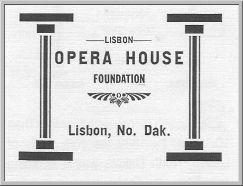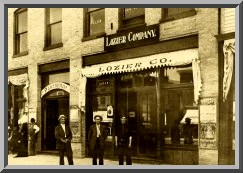Drop us a line and tell us when you are coming to Lisbon.
We can set up a tour of the Lisbon Opera House.
Tours by appointment only.
Although incorporated for less than 10 years, by 1889, the community of Lisbon, North Dakota was a booming railroad town. That summer a building was commissioned by Alice M. Beemis and her sister Mary Beemis Parsons on the east side of Main Street in the middle of the 400 block. Built and equipped at a cost of around $20,000, the three story brick building had a dignified facade with arched windows and a grand staircase leading from the front center of the ground floor to the second floor. In the years that followed, the first floor of this downtown landmark housed several different businesses, but the second and third floors were the heart and soul of the building.... the Lisbon Opera House. The "Opera House" name was a generic term referring to what we today would call a community center.
The Opera House very quickly became the center of Lisbon's social life with events such as plays, band concerts, conventions, graduation exercises and touring shows. In 1896 the building was purchased by E.C. Lucas who, along with his brother, operated the Lucas Brothers Drug Store. Lucas recruited nationally known talent like the Clint and Bessie Robbins touring company and by the turn of the century the Opera House was considered one of the finest found in a city the size of Lisbon. Some of the events held at this time were:
-
1901-- Memorial services for assassinated President William McKinley
-
1901-- Statewide W.C.T.U. Convention
-
1902-- State Republican Rally
-
1904-- Lisbon High School comic opera " The Captain of Plymouth"
By 1910, moving pictures had come to Lisbon and the first to be shown in the Opera House was "Birth of a Nation". However motion pictures coupled with orders by the Fire Marshal that more exits be installed, were to contribute to the decline of many of the types of events that had taken place in the Opera House and its use began to diminish.
The following plays were performed during the week of February 12th 1915:
-
Monday--- " The Brat"
-
Tuesday--- "Mary's Ankle"
-
Wednesday--- "A Pair of Sixes"
-
Thursday--- "Tilly the Mennonite"
-
Friday--- "Cappy Ricks"
-
Saturday--- "Please Get Married"
The last high school graduation held at the Opera House was in 1923 although school plays were performed there until the late 1920's. In 1954, in order to make more floor space on the first floor, the grand staircase was removed and replaced with a smaller staircase having an entrance on the northwest corner of the building facing Main Street.
In May of 1988, the JC Penney store which had occupied the first floor since about 1929 closed its doors and the building remained largely unused until the summer of 1994. That year, 105 years after being constructed, the Opera House acquired new life when it was donated to the Lisbon Opera House Foundation. This newly formed non-profit organization had as its goal the preservation and rehabilitation of this historic building. They wanted the Opera House once again to become a dynamic and useful part of Lisbon's social life.
The Lisbon Opera House was added to the National Register of Historic Places in 1979.
Major improvements to the building have been:
-
Outside rear staircase to provide an additional exit
-
Remodeling front facade to more closely resemble original
-
Remodeling the ground floor to make it usable for tenants
-
Replacement of 30 windows on the upper floors for energy efficiency while still retaining original look
-
Replacement of all wiring in the upper floors
-
Installation of an elevator
-
The making of a first floor community room with two bathrooms which can be rented out
-
Creating and finishing off rooms in the basement which can be rented out

